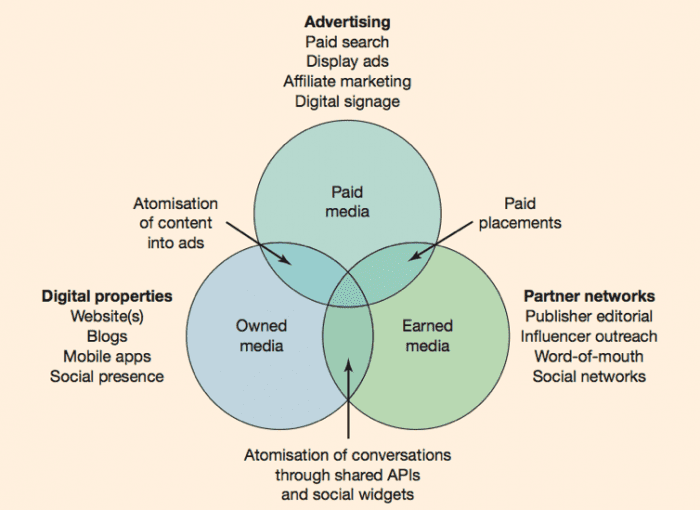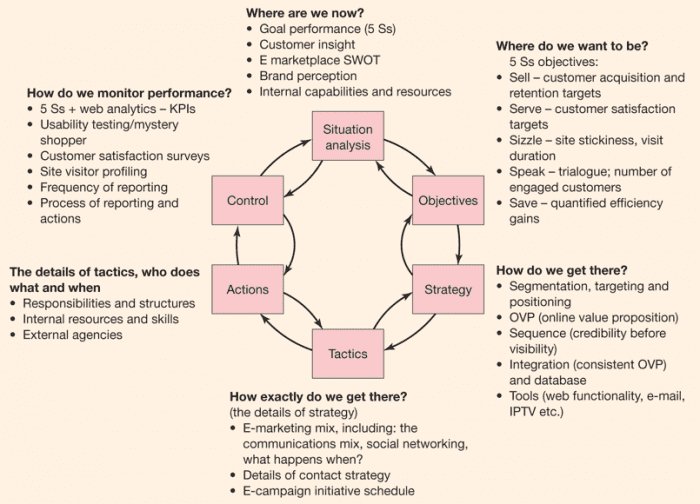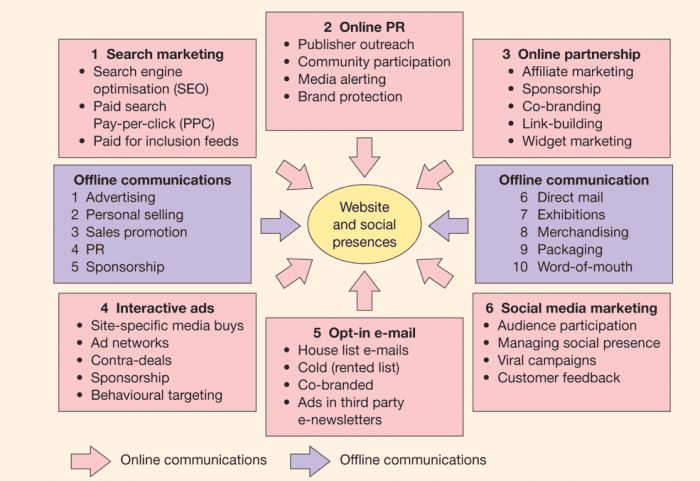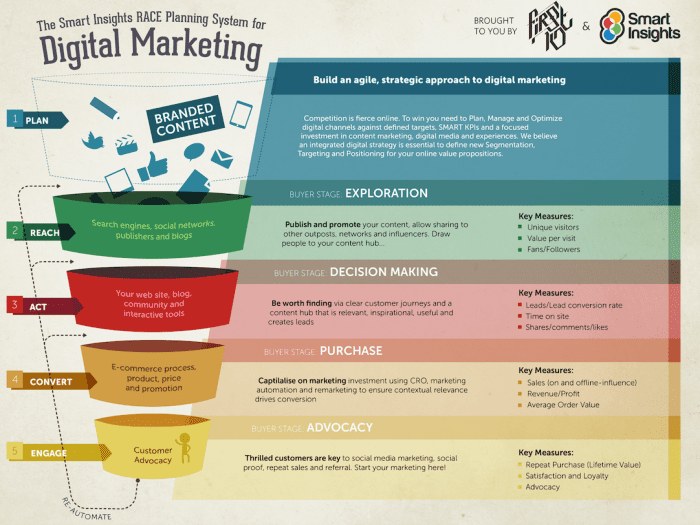What are the essential parts of a digital and digital transformation plan?
Digital or online marketing is any form of marketing that involves using online channels for goals of acquisition and retention. It also includes digital technology and use of data to target audiences more precisely with personalized messages. Since creating awareness and achieving conversion still commonly involve offline channels such as a call-centre or in-store, digital marketing plans need to define integration between channels using techniques like customer journey mapping.
The purpose of a digital marketing plan is to define how to compete more effectively with digital marketing. Its scope of a digital marketing plan is typically annual, but a digital transformation plan will typically be longer since this involves creating long-term roadmaps for implementing new technologies and ways of working. Digital media and technology offer new channels to market, so a digital transformation strategy is a channel strategy. This means that a digital strategy:
- Understand the channel.
Your strategy should be informed by customer online behaviour and preferences. In particular, understand which intermediary sites influence purchase and how your customers switch between the channels. - Set objectives for future channel contribution.
This includes specific monthly targets for both direct (online) sales and indirect (offline) sales. - Identify and prioritise target audiences.
As with traditional marketing, targeting the right audiences or personas is key. Digital media enable you to micro-target. - Encourage usage of the channel.
You may still need to communicate the benefits of using digital channels to encourage switching and enhance your brand. - Create propositions to emphasize the differences.
This includes differences between online channels and other channels. - Support integration between channels.
Although you want to emphasize the differences, that doesn’t mean the channel shouldn’t be integrated. Customer journeys should be seamlessly integrated. - Review how competitors use the channel.
Understand their targeting and propositions, where do they excel? - Develop channel partners.
Find the key players and influencers in the value chain or ecosystem and form strategic partnerships.
Selecting the best mix of digital media to meet your goals of customer acquisition and retention is a large part of a digital marketing strategy. There are a variety of paid, owned and earned media assets that fall within digital marketing, including, for example, your:
- Online brand
- Website and potentially mobile apps
- Blogs
- Automated email communications, promotions and e-newsletters
- Social media channels
- Digital advertising
- Online PR
- Partner co-marketing and affiliate marketing
A digital marketing plan provides a clear picture of how the combination of different media supports an organization’s goals and objectives. The purpose of a digital marketing plan is to ensure that digital marketing activities are relevant and timely in the achievement of your organization’s objectives, that they can be implemented with available resources and that they are capable of creating and sustaining a competitive position online.
In a large organization, a digital marketing plan may be part of a number of integrated marketing plans, specific to individual parts of the business.
When to use it?
Digital marketing planning is an effective way of strategically organizing your digital marketing tactics and effectively measuring their success. A digital marketing plan provides clear strategic targets for what you want to achieve from your online marketing activities. Implementation can provide numerous benefits:
- Clear and agreed targets including a roadmap of changes to people, process and technology needed for digital transformation
- Clear and agreed targets including a roadmap of changes to people, process and technology needed for digital transformation
- A competitive edge and increased share of the market through better use of digital media than competitors
- Valuable customer insights and analytics such as popular content, demographics, devices used and buying behaviours
- A powerful online customer value proposition to achieve differentiation, customer engagement and to encourage loyalty
- Reduces the likelihood of duplication, particularly in larger organizations
- Provides your organization with the agility to catch up or stay ahead
- Measures how many people are engaging with your content and how many qualified leads are being generated
An effective digital marketing plan will enable you to distinguish behaviour patterns and trends throughout your customer’s journey, providing you with the ability to make informed decisions and improvements at every stage of this journey.
What should be included? / How should it be structured?
A digital marketing plan typically includes:
- A review of your organization’s digital capabilities
- Setting SMART objectives to grow online leads and direct online or indirect offline sales
- Defining the digital marketing methods to be invested in
- Defining the resources required for digital marketing
A useful tool for reviewing and defining your digital marketing capabilities and resources is the SOSTAC structure which we explain in our 7 steps strategy guide.
Introducing SOSTAC®
To make sure your digital marketing plan has all the essential features, I recommend the SOSTAC® structure developed by PR Smith—Dave Chaffey’s co-author of the printed book Digital Marketing Excellence.
SOSTAC® is a great framework for structuring business, marketing or digital marketing plans since it’s relatively simple and logical, so it’s easy to remember and to explain to colleagues or agencies. SOSTAC® is a strategic planning process framework that gives you a clear structure to work through to create and manage your plan.
This chart from Digital Marketing Excellence summarises what should be included in each part of a SOSTAC® plan.
So, what does SOSTAC® stand for?
Situation analysis means ‘Where are we now?’ For digital marketing planners, questions include:
- Which digital channels are being used by our customers?
- How are our competitors meeting the needs of our target customers?
- Which digital marketing tactics are they using?
- How can we stand out from our competitors?
Objectives mean ‘Where do we want to be?’
- How do we ensure alignment with our business’ goals and key performance indicators?
- What are the top-level goals 5 Ss (Sell, Serve, Speak, Save and Sizzle)?Here we can build specific and measurable digital marketing plan targets. Good objectives are quantified against timescales e.g. to increase our conversion rate by 5% per month, to generate 100 new online leads per quarter.
Strategy means ‘How do we get there?’ Strategy summarizes how to fulfill the objectives. It is the shortest part of the plan, but arguably, the most important, as it gives direction to all the subsequent tactics. It answers questions including:
- How do we position ourselves in order to gain a competitive advantage?
- How will digital marketing plan targets be achieved?
- What messaging, technologies and channels will we use?
Tactics are the details of strategy. They highlight on a digital marketing plan exactly which tactics occur when. Your chosen tactics should support and adhere to your customer’s journey. Examples of digital marketing tactics could include, for example:
- Content marketing
- Social media marketing
- E-mail marketing
- Online PR coverage
- Search Engine Optimization (SEO)
- Pay-Per-Click (PPC) marketing
- Native advertising
- Affiliate marketing
- Inbound marketing
I recommend you consider these 6 options defined in this diagram. In reality you will specify more detail for each channel as listed in our Digital media cheatsheet, which gives a succinct summary of the main organic and paid media options on Google and in the social network.
Action is the detailed planning of tactics. Who does what, when and how? What processes and activities are required to make things happen?
Control identifies what you need to measure when and what happens. The Control section of the plan ensures you know if you are succeeding or failing – and you can make adjustments– before it is too late. How you measure the success of your digital marketing activities will be based upon the overall marketing objectives detailed in your marketing plan.
To help you plan your digital marketing tactics effectively, the RACE Planning system will provide you with a simple framework.
Why use RACE for planning and managing digital marketing?
RACE is a practical framework to help manage and improve results from your digital marketing. Ultimately it’s about using best practice across digital marketing techniques to get more commercial value from investments in digital marketing. It will help simplify your approach to reviewing the performance of your online marketing and taking actions to improve its effectiveness.
Although SOSTAC® provides a superb framework for structuring a plan, I recommend that a digital marketing plan combines it with the Smart Insights RACE planning framework since:
- RACE is practical and action-oriented – it focuses on tactics you can implement in your digital marketing communications and on your website and mobile apps
- RACE is customer-centred – it follows the established customer lifecycle of relationship building or marketing funnel from creating awareness; generating leads from new prospects; converting prospects to sale online or offline and encouraging loyalty, repeat sales and advocacy such as social sharing.
- RACE integrates performance evaluation – It defines KPIs that digital marketers should include at each stage for setting targets and reviewing results using analytics and summary dashboards.
What is RACE?
RACE covers the full customer lifecycle or marketing funnel from:
(Plan) > Reach > Act > Convert > Engage
There is also an initial phase of Plan involving creating the overall digital strategy, objective setting and plan.
RACE consists of four steps or online marketing activities designed to help brands engage their customers throughout the customer lifecycle. This infographic shows the goals for each part of RACE and how you can measure them.
- Reach.
Reach involves building awareness and visibility of your brand, products and services on other websites and in offline media in order to build traffic by driving visits to different web presences like your main site, microsites or social media pages. It involves maximising reach over time to create multiple interactions using different paid, owned and earned media touchpoints. - Act.
Act is short for Interact. It’s a separate stage from conversion since encouraging interactions on websites and in social media. For most businesses, the main aim of Act is to generate online leads. So, it’s about persuading site visitors or prospects take the next step, the next Action on their customer journey when they initially reach your site or social network presence. It may mean finding out more about a company or its products, searching to find a product or reading a blog post.You should define these actions as top-level goals of the funnel in analytics. Goals can include “Viewed product”, “Added to Basket”, “Registered as member” or “Signed up for an e-newsletter. Act is also about encouraging participation. This can be sharing of content via social media or customer reviews (strictly, part of Engage). - Convert.
This is simply conversion to sale, online or offline. It involves getting your audience to take that vital next step which turns them into paying customers whether the payment is taken through online Ecommerce transactions, or offline channels. - Engage.
This is long-term customer engagement and communications that is, developing a long-term relationship with first-time buyers to build customer loyalty as repeat purchases using communications on your site, social presence, email and direct interactions to boost customer lifetime value. It can be measured by repeat actions such as repeat sale and sharing content through social media. We also need to measure percentage of active customers (or email subscribers) and customer satisfaction and recommendation using other systems.
The Smart Insights Multichannel Marketing Growth Wheel infographic gives a visual view of key planning activities that are needed as part of the process of producing an integrated digital marketing plan.
A solid digital marketing plan has:
- Clear, realistic goals which you can be confident of hitting
- The best strategy to achieve these goals against your competition
- Sufficient details of the tactics and actions needed to translate the strategy into action
- A method to check you are on track with your plans
Which type of business is it most suited for?
A digital marketing plan can be a valuable asset to any organization. Regardless of what you sell, a digital marketing plan will enable you to:
- Develop customer personas
- Establish customer needs
- Craft valuable online content
How your digital marketing plan is implemented will differ, depending on whether you are a Business to Business (B2B) or Business to Consumer (B2C) organization, for example:
Online lead generation tends to be the goal of B2B organizations, so the focus of your marketing plan will be attracting and converting quality leads via your website and digital channels for your sales teams.
Providing an enhanced customer journey tends to be the focus of B2C organizations, so the focus of your marketing plan will be attracting prospective online customers and converting them, without the input of a sales team.
How does it relate to other plans?
Digital marketing activities work best when integrated with traditional marketing and response channels. Organizations should therefore have a separate digital marketing plan, which is integrated into an overall marketing plan. As recognized in 10 reasons you need a digital marketing strategy in 2017, this ensures that digital marketing is fully aligned and becomes part of business as usual.
Dave Chaffey, CEO and co-founder of Smart Insights, notes that the creation of digital plans often occurs in two stages:
“First, a separate digital marketing plan is created. This is useful to get agreement and buy-in by showing the opportunities and problems and map out a path through setting goals and specific strategies for digital including how you integrated digital marketing into other business activities.
Second, digital becomes integrated into marketing strategy, it’s a core activity, “business-as-usual”, but doesn’t warrant separate planning, except for the tactics.”
source http://www.smartinsights.com/manage-digital-transformation/digital-transformation-strategy/structure-effective-digital-transformation-plan/




As a Client and web user I can completely agree with the author. If a business man can over come this and apply the useful information shared here can result in good output. Also visit Fast IT Solutions for more information.
ReplyDelete